Gear Hobs—Cutting Tools and Manufacturing Technologies for Spur Gears: The State of the Art
Abstract
:1. Introduction
2. A Literature Review
2.1. The Gear Hobbing Processes
2.1.1. The Mechanism of the Gear Hobbing Process
- Main cutting motion as the rotation about the gear hob’s own axis, characterized by the cutting velocity , the rotation , and the angular speed ;
- Circular feed motion as the rotation of the blank about its own axis, characterized by the rotation , and the angular velocity .
- Axial feed motion is the linear motion of the gear hob slider along the workpiece’s axis.
2.1.2. Chip-Forming
2.1.3. Cutting Forces
2.1.4. Temperature during the Gear Hobbing Process
2.1.5. Wear and Durability of Gear Hobs
2.1.6. Other General Aspects of Gear Hobbing Processes
2.1.7. Gear Hobbing Machine Tools
2.2. Gear Hobs
- The constructive solution (single block vs. cutting inserts);
- Design;
- Cutting materials;
- The rake face and regrinding;
- Undercuts.
2.2.1. The Constructive Solution
- A positive rake angle, which provides good cutting conditions through the way the cutting edge approaches the workpiece;
- A planar rake face, tilted against the gear hob’s axis.
2.2.2. Designing the Gear Hobs
2.2.3. Cutting Materials
2.2.4. The Rake Face and Its Regrinding
2.2.5. Undercuts
2.2.6. Manufacturing of Gear Hobs
- Gear hobbing in several aspects, such as chip-forming, temperature in the cutting area and lubrication, cutting forces, cutting parameters, and others;
- Manufacturing (and maintenance—regrinding/sharpening) of the gear hobs.
3. Discussion
3.1. A Literature Systematization
3.2. Some Gaps and Bottlenecks in the Current Research
- Still assuming simplifying hypotheses in determining the gear hobs geometry, with bad consequences on the gear hobs’ geometrical precision;
- The CAD/CAM systems facilities are not exploited enough for their entire potential in simulating the cutting processes and designing the gear hobs, observing interferences between the cutting tool and workpiece, and hence undercuts;
- The gear hobs used for finishing are designed and produced exclusively with a 0° rake angle, with bad implications for the cutting conditions—unjustified big cutting forces;
- The gear hobs lose their precision after regrinding because of the decrease in diameter and alteration of the cutting angles and the edge line shape;
- Undercuts do not allow the correct regrinding of the gear hob;
- A gear hob having a planar rake face would be free of some problems related to determining the cutting edge profile and regrinding;
- The problem of low geometrical precision of the composite gear hob persists, and is not studied enough;
- Despite cooling being a sensible issue at gear hobbing, inner cooling is neither applied, nor studied;
- The clearance faces of the gear hob teeth are turned and ground on the relieving lathe; thus, due to the helical relieving process, the side relief angles result in small values;
- Almost not at all exploited the specific features of CNC machine tools in gear hobs manufacturing.
3.3. Future Research Directions
3.3.1. General Directions for Research on Gearing Cutting Tools and Processes
3.3.2. Future Research Directions
- Adopting new, innovative strategies to determine the gear hobs profile, which do not need simplification, so they lead directly to a real profile that matches perfectly the theoretical one;
- New principles of designing, manufacturing technologies, and regrinding technologies that preserve the correctness of the gear hob precision (shape) after regrinding;
- New geometries of the gear hobs that allow regrinding without undercuts; here can be mentioned the possibility of designing and producing gear hobs with a planar rake face;
- New, or improved technologies to determine the theoretical profile of the gear hob on the rake face positively angled. The result would be a two-in-one gear hob that combines the effectiveness of the roughing gear hobs (positive rake angle) with the precision of the finishing gear hobs (zero-angled rake face);
- New but still machinable shape of the clearance face that ensures an adequate clearance angle of the side-cutting edges.
3.3.3. Main Requirements for Improving the Gear Hobbing Technologies
- Higher productivity (effectiveness), with the following measures to be taken:
- Applying to an extended scale the high-speed machining;
- Cutting processes with increased feed rate;
- Optimized cutting parameters;
- New cutting materials that offer the cutting tool increased durability;
- Use gear hobs with adequate geometry that allow both roughing and finishing gears by the same gear hob.
- Higher geometrical and dimensional precision of the products: gear hobs, and hence the gears machined, with the following measures to be taken:
- Designing and producing gear hobs with a teeth profile free of errors;
- Designing and producing gear hobs able to preserve the profile precision after regrinding;
- Adequate clearance angle along the entire cutting edge of the gear hob teeth;
- Cutting methods that ensure an even wear of all the teeth of the gear hob.
- Eco-friendly technologies with the following measures to be taken:
- Applying the MQL lubricating, and mostly, dry machining;
- Giving up the mineral lubricants, and replacing them with eco-friendly cutting fluids;
- Applying inner cooling;
- Any measure meant to save energy;
- Approaching the cutting tools (design and production) and cutting processes in an integrated manner that takes into account the carbon footprint along the entire life of the product.
4. Conclusions
- A systematization of the literature, according to two main areas, gear hobs, and gear hobbing processes, with their subdomains;
- Identifying some gaps in the literature that need to be filled in by new research;
- Stating some new future research directions.
Author Contributions
Funding
Institutional Review Board Statement
Informed Consent Statement
Data Availability Statement
Conflicts of Interest
References
- Rominger, G.S. Worm. Gear. Cutting Machine. U.S. Patent 405,030, 24 January 1893. [Google Scholar]
- Baerbalck, H.; Hamilton, O.H.; Carr, R.S. Relieving Mechanism for Engine Lathes. U.S. Patent 870,759, 12 November 1907. [Google Scholar]
- Fellows, L.E.R. Machine for Grinding Gear Generating Cutters. U.S. Patent 686,599, 12 November 1890. (Application filed 24 June 1899). [Google Scholar]
- Verified Market Reports. Available online: https://www.verifiedmarketreports.com/product/gear-manufacturing-market/ (accessed on 1 March 2024).
- Boral, P.; Gołębski, R.; Kralikova, R. Technological aspects of manufacturing and control of gears—Review. Materials 2023, 16, 7453. [Google Scholar] [CrossRef] [PubMed]
- Xiao, Q.; Li, C.; Tang, Y.; Pan, J.; Yu, J.; Chen, X. Multi-component energy modeling and optimization for sustainable dry gear hobbing. Energy 2019, 187, 115911. [Google Scholar] [CrossRef]
- Web of Science. Available online: https://www.webofscience.com/wos/woscc/full-record/WOS:000245459700171 (accessed on 2 March 2024).
- Chu, C.T.; Shen, S.H.; Hu, C.Y.; Chen, C.C. A universal hob for corrected circular arc-tooth point-meshing gears. Sci. Sinica 1963, 12, 723. [Google Scholar]
- Litvin, F.L.; Fuentes, A. Gear Geometry and Applied Theory; Cambridge University Press: Cambridge, UK, 2009. [Google Scholar]
- Máté, M. Cylindrical Gear Cutting Tools; Transylvanian Museum Society: Cluj Napoca, Romania, 2016; ISBN 978-606-739-070-4. (In Hungarian) [Google Scholar]
- Ueda, Y.; Sakurai, N.; Takagi, T.; Ishizu, K.; Yan, J. Exploratory investigation of chip formation and surface integrity in ultra-high-speed gear hobbing. CIRP Ann. 2022, 71, 89–92. [Google Scholar] [CrossRef]
- Bouzakis, K.D.; Friderikos, O.; Tsiafis, I. FEM-supported simulation of chip formation and flow in gear hobbing of spur and helical gears. CIRP J. Manuf. Sci. Technol. 2008, 1, 18–26. [Google Scholar] [CrossRef]
- Habibi, M.; Chen, Z.C. A semi-analytical approach to un-deformed chip boundary theory and cutting force prediction in face-hobbing of bevel gears. Comput. Aided Des. 2016, 73, 53–65. [Google Scholar] [CrossRef]
- Troß, N.; Brimmers, J.; Bergs, T. Calculation of the maximum chip thickness for a radial-axial infeed in gear hobbing. Procedia CIRP 2021, 99, 232–236. [Google Scholar] [CrossRef]
- Norbert Hodgyai, N.; Tolvaly-Roșca, F.; Máté, M. A Comparison between a Classical and a Modified Root Fillet. Műszaki Tudományos Közlemények 2021, 15, 25–32. [Google Scholar] [CrossRef]
- Mikołajczyk, T.; Latos, H.; Pimenov, D.Y.; Paczkowski, T.; Gupta, M.K.; Krolczyk, G. Influence of the main cutting edge angle value on minimum uncut chip thickness during turning of C45 steel. J. Manuf. Process. 2020, 57, 354–362. [Google Scholar] [CrossRef]
- Kaçal, A.; Gulesin, M.; ULAŞ, H. System design and manufacturing for measurement of cutting forces in gear hobbing process. J. Fac. Eng. Archit. Gazi Univ. 2010, 23, 795–800. [Google Scholar]
- Brecher, C.; Brumm, M.; Krömer, M. Design of gear hobbing processes using simulations and empirical data. Procedia CIRP 2015, 33, 484–489. [Google Scholar] [CrossRef]
- Abe, T.; Fukunaga, K. Gear precision and cutting force at dry hobbing gear cutting for gears made of brass material. Key Eng. Mater. 2010, 447–448, 297–300. [Google Scholar] [CrossRef]
- Stark, S.; Beutner, M.; Lorenz, F.; Lampke, T.; Karpuschewski, B.; Halle, T. Experimental and numerical determination of cutting forces and temperatures in gear hobbing. Key Eng. Mater. 2012, 504–506, 1275–1280. [Google Scholar] [CrossRef]
- Bouzakis, K.D.; Lili, E.; Michailidis, N.; Friderikos, O. Manufacturing of cylindrical gears by generating cutting processes: A critical synthesis of analysis methods. CIRP Ann. 2008, 57, 676–696. [Google Scholar] [CrossRef]
- Frǎţilǎ, D.F. Research of environment-friendly techniques influence on gear accuracy in context of sustainable manufacturing. Proc. Rom. Acad. Ser. A—Math. Phys. Tech. Sci. Inf. Sci. 2013, 14, 56–63. [Google Scholar]
- Gupta, K.; Laubscher, R.; Davim, J.P.; Jain, N. Recent developments in sustainable manufacturing of gears: A review. J. Clean. Prod. 2016, 112, 3320–3330. [Google Scholar] [CrossRef]
- Yldiz, Y.; Nalbant, M. A review of cryogenic cooling in machining processes. Int. J. Mach. Tools Manuf. 2008, 48, 947–964. [Google Scholar] [CrossRef]
- Troß, N.; Brimmers, J.; Bergs, T. Tool wear in dry gear hobbing of 20MnCr5 case-hardening steel, 42CrMo4 tempered steel and EN-GJS-700-2 cast iron. Wear 2021, 476, 203737. [Google Scholar] [CrossRef]
- Fratila, D. Evaluation of near-dry machining effects on gear milling process efficiency. J. Clean. Prod. 2009, 17, 839–845. [Google Scholar] [CrossRef]
- Kharka, V.; Jain, N.K.; Gupta, K. Sustainability and performance assessment of gear hobbing under different lubrication environments for manufacturing of 20MnCr5 spur gears. Sustain. Mater. Technol. 2022, 31, e00388. [Google Scholar]
- Kharka, V.; Jain, N.K.; Gupta, K. Influence of MQL and hobbing parameters on microgeometry deviations and flank roughness of spur gears manufactured by MQL assisted hobbing. J. Mater. Res. Technol. 2020, 9, 9646–9656. [Google Scholar] [CrossRef]
- Kharka, V.; Jain, N.K.; Gupta, K. Performance comparison of green lubricants in gear hobbing with minimum quantity lubrication. Tribol. Int. 2022, 173, 107582. [Google Scholar] [CrossRef]
- Zhang, S.; Sun, Z.; Guo, F. Investigation on wear and contact fatigue of involute modified gears under minimum quantity lubrication. Wear 2021, 484, 204043. [Google Scholar] [CrossRef]
- Yuan, S.M.; Yan, L.T.; Liu, V.D.; Liu, O. Effects of cooling air temperature on cryogenic machining of Ti–6Al–4V alloy. J. Mater. Process. Technol. 2011, 211, 356–362. [Google Scholar] [CrossRef]
- Sujan, D.; Moola, M.R.; Qua, S.Y. Environmental friendly cutting fluids and cooling techniques in machining: A review. J. Clean. Prod. 2014, 83, 33–47. [Google Scholar] [CrossRef]
- Dong, X.; Liao, C.; Shin, Y.; Zhang, H. Machinability improvement of gear hobbing via process simulation and tool wear predictions. Int. J. Adv. Manuf. Technol. 2016, 86, 2771–2779. [Google Scholar] [CrossRef]
- Cheng, Y.N.; Ma, C.; Zhang, J.; Zhou, H.; Xin, L.; Wang, X. Simulation and experimental study of tool wear in high-speed dry gear hobbing. Int. J. Adv. Manuf. Technol. 2022, 119, 3181–3204. [Google Scholar] [CrossRef]
- Bouzakis, K.D.; Kombogiannis, S.; Antoniadis, A.; Vidakis, N. Gear hobbing cutting process simulation and tool wear prediction models. J. Manuf. Sci. Eng. 2002, 124, 42–51. [Google Scholar] [CrossRef]
- Karpuschewski, B.; Beutner, M.; Köchig, M.; Härding, C. Influence of the tool profile on the wear behaviour in gear hobbing. CIRP J. Manuf. Sci. Technol. 2018, 18, 128–134. [Google Scholar] [CrossRef]
- Khalilpourazary, S.; Meshkat, S.S. Investigation of the effects of alumina nanoparticles on spur gear surface roughness and hob tool wear in hobbing process. Int. J. Adv. Manuf. Technol. 2014, 71, 1599–1610. [Google Scholar] [CrossRef]
- Stachurski, W.; Kruszynski, B. Influence of cutting speed on the hob wear in hobbing with the minimum quantity lubrication. The. Vjesn. 2020, 27, 341–345. [Google Scholar] [CrossRef]
- Kühn, F.; Löpenhaus, C.; Brimmers, J.; Klocke, F.; Bergs, T. Analysis of the influence of the effective angles on the tool wear in gear hobbing. Int. J. Adv. Manuf. Technol. 2020, 108, 2621–2632. [Google Scholar] [CrossRef]
- Klocke, F.; Gorgels, C.; Weber, G.-T.; Schalaster, R. Prognosis of the local tool wear in gear finish hobbing. Prod. Eng. Res. Dev. 2011, 5, 651–657. [Google Scholar] [CrossRef]
- Balajti, Z.; Ábel, J.; Dudás, I. Examination for post-sharpening adjustment of cutting edge of a worm gear hob with circle arched profile in axial section. Procedia Manuf. 2021, 55, 260–265. [Google Scholar] [CrossRef]
- Balajti, Z.; Ábel, J. Edge geometry test method with correctly positioned CCD cameras for production geometrical development of a worm gear hob with arched profile. Procedia Manuf. 2020, 51, 365–372. [Google Scholar] [CrossRef]
- Claudin, C.; Rech, J. Development of a new rapid characterization method of hob’s wear resistance in gear manufacturing—Application to the evaluation of various cutting edge preparations in high speed dry gear hobbing. J. Mater. Process. Technol. 2009, 29, 5152–5160. [Google Scholar] [CrossRef]
- Shih, Y.P. Mathematical model for face-hobbed straight bevel gears. J. Mech. Des. 2012, 134, 091006. [Google Scholar] [CrossRef]
- Shih, Y.P. Manufacture of face-hobbed straight bevel gears using a six-axis CNC bevel gear cutting machine. Int. J. Adv. Manuf. Technol. 2013, 69, 2499–2515. [Google Scholar] [CrossRef]
- Kim, J.H.; Kim, D.H. Evaluation of fatigue life of automotive bevel gear. Key Eng. Mater. 2006, 324–325, 839–842. [Google Scholar] [CrossRef]
- Efstathiou, C.; Tapoglou, N. Simulation of spiral bevel gear manufacturing by face hobbing and prediction of the cutting forces using a novel CAD-based model. Int. J. Adv. Manuf. Technol. 2022, 122, 3789–3813. [Google Scholar] [CrossRef]
- Simon, V.V. Influence of tooth modifications on tooth contact in face-hobbed spiral bevel gears. Mech. Mach. Theory 2011, 46, 1980–1998. [Google Scholar] [CrossRef]
- Simon, V.V. Optimal machine-tool settings for the manufacture of face-hobbed spiral bevel gears. J. Mech. Des. 2014, 136, 081004. [Google Scholar] [CrossRef]
- Yang, J.; Li, H.T. A method to generate the spiral flutes of an hourglass worm gear hob. J. Mech. Des. 2018, 140, 063301. [Google Scholar] [CrossRef]
- Suh, S.H.; Jih, W.; Hong, H.; Chung, D. Sculptured surface machining of spiral bevel gears with CNC milling. Int. J. Mach. Tools Manuf. 2001, 41, 833–850. [Google Scholar] [CrossRef]
- Liu, S.Y.; Song, C.S.; Zhu, C.C.; Liang, C.C.; Bai, H. Investigation on contact and bending stress of face-hobbed and face-milled hypoid gear. Mech. Mach. Theory 2020, 150, 103873. [Google Scholar] [CrossRef]
- Zhang, W.Q.; Cheng, B.; Guo, X.; Zhang, M.; Xing, Y. A motion control method for face hobbing on CNC hypoid generator. Mech. Mach. Theory 2015, 97, 127–143. [Google Scholar] [CrossRef]
- Gonzalez-Perez, I.; Fuentes-Aznar, A. An exact system of generation for face-hobbed hypoid gears: Application to high reduction hypoid gear drives. Mech. Mach. Theory 2023, 179, 105115. [Google Scholar] [CrossRef]
- Huang, K.F.; Yu, J.W.; Luo, H.; Shang, Z.T.; Huang, S.; Fu, L. An efficient vectorization solution to cutting dynamics modeling for face-hobbing of hypoid gears. Mech. Mach. Theory 2024, 191, 105504. [Google Scholar] [CrossRef]
- Fan, Q. Computerized modeling and simulation of spiral bevel and hypoid gears manufactured Gleason face hobbing process. J. Mech. Des. 2006, 128, 1315–1327. [Google Scholar] [CrossRef]
- Hu, Z.Q.; Li, Y.K. Design of 4-axis reconfigurable CNC machine tool for relief grinding sphere gear hob. Adv. Mater. Res. 2011, 201–203, 561–564. [Google Scholar] [CrossRef]
- Dimitriou, V.; Antoniadis, A. CAD-based simulation of the hobbing process for the manufacturing of spur and helical gears. Int. J. Adv. Manuf. Technol. 2009, 41, 347–357. [Google Scholar] [CrossRef]
- Matsuo, K.; Suzuki, Y.; Fujiki, K. Analysis of the effect on gear accuracy of workpiece/tool positioning accuracy in the hobbing process. J. Adv. Mech. Des. Syst. Manuf. 2017, 11, JAMDSM0071. [Google Scholar] [CrossRef]
- Wu, D.Y.; Yan, P.; Guo, Y.; Zhou, H.; Yi, R. Integrated optimization method for helical gear hobbing parameters considering machining efficiency, cost and precision. Int. J. Adv. Manuf. Technol. 2001, 113, 735–756. [Google Scholar] [CrossRef]
- Cao, W.D.; Yan, C.P.; Ding, L.; Ma, Y.F. A continuous optimization decision making of process parameters in high-speed gear hobbing using IBPNN/DE algorithm. Int. J. Adv. Manuf. Technol. 2016, 85, 2657–2667. [Google Scholar] [CrossRef]
- Liu, G.H.; Yan, H.Z.; Zhang, J.J. Optimization of cutting/tool parameters for dry high-speed spiral bevel and hypoid gear cutting with cutting simulation experiment. Int. J. Adv. Manuf. Technol. 2012, 472–475, 2088–2095. [Google Scholar] [CrossRef]
- Ni, H.X.; Yan, C.; Ge, W.; Ni, S.; Sun, H.; Xu, T. Integrated optimization of cutting parameters and hob parameters for energy-conscious gear hobbing. Int. J. Adv. Manuf. Technol. 2022, 118, 1609–1626. [Google Scholar] [CrossRef]
- Cao, W.D.; Yan, C.P.; Wu, D.J.; Tuo, J.B. A novel multi-objective optimization approach of machining parameters with small sample problem in gear hobbing. Int. J. Adv. Manuf. Technol. 2017, 93, 4099–4110. [Google Scholar] [CrossRef]
- Liang, D.; Chen, B.; Gao, Y. Hobbing manufacturing of new type of involute-helix gears for wind turbine gearbox. Int. J. Precis. Eng. Manuf. Technol. 2019, 6, 305–313. [Google Scholar] [CrossRef]
- Radzevich, S.P. A way to improve the accuracy of hobbed involute gears. J. Mech. Des. 2007, 129, 1076–1085. [Google Scholar] [CrossRef]
- Ainoura, M.; Yonekura, M.; Nagano, K. A study on finishing of hardened gears by carbide hob and the accuracy of hobbed gear. Bull. JSME 1983, 26, 682. [Google Scholar] [CrossRef]
- Yonekura, M.; Sugimoto, T.; Sumi, M.; Kumagai, F.; Nagano, K.; Sakuragi, I. A study on finish hobbing with carbide hob: Improvement of gear accuracy using new hobbing machine. JSME Int. J. Ser. C Mech. Syst. Mach. Elem. Manuf. 1998, 41, 291–298. [Google Scholar] [CrossRef]
- Hiroo, Y.; Sakuragi, I.; Kunitake, Y.; Satayotin, K. Gear tooth error caused by hob misalignment. In Proceedings of the International Conference on Mechanical Transmissions, Vols 1 and 2; Chongqing University: Chongqing, China, 2006; pp. 862–867. [Google Scholar]
- Gao, H.Q.; Wang, S.W.; Chen, Q.G. Analysis and strategy on gear-shape error. Appl. Mech. Mater. 2011, 42, 347–350. [Google Scholar] [CrossRef]
- Wang, Y.Z.; Xu, H.K.; Shen, H.; Wang, G.; Wang, Z.; Vasques, C. A study on the effect of gear hobbing process parameters on the residual stress of the tooth root. Appl. Sci. 2024, 14, 597. [Google Scholar] [CrossRef]
- Yagishita, H. Dynamic rotational accuracy of a middle size gear hobbing machine and the gear cutting performance. Experimental study on the evaluation of generating accuracy of gear teeth in the hobbing machine. Bull. Jpn. Soc. Precis. Eng. 1981, 15, 7–13. [Google Scholar]
- Vasiloni, A.M.; Dragoi, M.V. Smart Adaptive CNC Machining—State of the Art. In Proceedings of the International Conference Innovative Manufacturing Engineering Conference (IManE), Chisinau, Republic of Moldova, 29–30 May 2014. [Google Scholar]
- Liu, X.; Zhao, F.; Mei, X.S.; Tao, T.; Shen, J.G. High-efficiency gear hobbing technics based on fuzzy adaptive control of spindle torque. J. Mech. Eng. Sci. 2019, 233, 3331–3345. [Google Scholar] [CrossRef]
- Kosarev, O. An automated-system for checking the accuracy of the kinematic chains on gear hobbing machines. Sov. Eng. Res. 1985, 5, 60–62. [Google Scholar]
- Azvar, M.; Katz, A.; Van Dorp, J.; Erkorkmaz, K. Chip geometry and cutting force prediction in gear hobbing. CIRP Ann. 2021, 70, 95–98. [Google Scholar] [CrossRef]
- Zhao, W.H.; Liu, Z.; Yang, Y.; Zou, Z.; Shu, R.Z.; Lei, S.C.; Gao, X. Improving the transmission error source tracing method for gear hobbing machines. Adv. Mech. Eng. 2022, 14, 1–11. [Google Scholar] [CrossRef]
- Piotrowski, A.; Golebski, R.; Boral, P. Geometric analysis of composite hobs. Trans. Famena 2020, 44, 43–54. [Google Scholar] [CrossRef]
- Nieszporek, T.; Piotrowski, A. Enhancing the Accuracy of Composite Hobs. In Proceedings of the XXI PolishSslovak Scientific Conference Machine Modeling and Simulations, Hucisko, Poland, 17 May 2007. [Google Scholar]
- Hu, Y.; Xiang, M.J.; Qiu, X.; Song, P.F.; Song, J.A.; Peng, F.H. An improved design of inserted tooth finishing hob for involute gears. J. Mech. Sci. Technol. 2014, 28, 3203–3208. [Google Scholar] [CrossRef]
- Hsieh, J.K.; Tseng, H.C.; Chang, S.L. A novel hob cutter design for the manufacture of spur-typed cutters. J. Mater. Process. Technol. 2009, 209, 847–855. [Google Scholar] [CrossRef]
- Huang, C.L.; Lee, G.S.; Chang, L.S. A new solution for sharpening helical flute hobs. Mech. Mach. Theory 2021, 164, 104419. [Google Scholar] [CrossRef]
- Moderow, R. The Right and Wrong of Modern Hob Sharpening. In Proceedings of the 19th Annual Gear Manufacturing Simposyum, Chicago, IL, USA, 7–9 April 1991. [Google Scholar]
- Kolesov, N.V.; Domnin, P.V.; Zav’yalov, S.S. Disk tool for machining helical surfaces. Russ. Eng. Res. 2015, 35, 290–291. [Google Scholar] [CrossRef]
- Yoshino, H.; Ishibashi, A. A method for calculating grinding wheel-profile for hob finishing—Design and manufacture of gear cutting tools and gears with an arbitrary profile. JSME Int. J. Ser. III Vib. Control. Eng. Eng. Ind. 1989, 32, 124–130. [Google Scholar] [CrossRef]
- Sambhav, K.; Tandon, P.; Dhande, S.G. A generic mathematical model of single point cutting tools in terms of grinding parameters. Appl. Math. Model. 2011, 35, 5143–5164. [Google Scholar] [CrossRef]
- Jiang, H.; Han, J.; Tian, X.; Lu, Y.; Li, G.; Xia, L. Research on generating gear grinding machining error based on mapping relationship between grinding wheel surface and tooth flank. Machines 2022, 10, 1202. [Google Scholar] [CrossRef]
- Zhao, X.F.; Lin, Y.; Liu, H.Q.; Zhang, J. Research on increasing hob tip fillet radius to decrease addendum modification coefficient. Appl. Mech. Mater. 2013, 271–272, 1105–1109. [Google Scholar] [CrossRef]
- Gherghina, G.; Tutunea, D.; Popa, D.; Bogdan, M.L.; Lambrache, N. The method of design and manufacturing of the gear hobbing cutter with bulges. Appl. Mech. Mater. 2014, 657, 13–17. [Google Scholar] [CrossRef]
- Mitchiner, R.G.; Mabie, H.H.; Moosavi-Rad, H. The undercutting of hobbed spur gear teeth. J. Mech. Des. 1983, 105, 22–128. [Google Scholar] [CrossRef]
- Tseng, J.T.; Tsay, C.B. Undercutting and contact characteristics of cylindrical gears with curvilinear shaped teeth generated by hobbing. J. Mech. Des. 2006, 128, 634–643. [Google Scholar] [CrossRef]
- Karpuschewski, B.; Knoche, H.-J.; Hipke, M.; Beutner, M. High performance gear hobbing with powder-metallurgical High-Speed-Steel. Procedia CIRP 2013, 1, 196–201. [Google Scholar] [CrossRef]
- Kobialka, C. Contemporary gear hobbing—Tools and process strategies. VDI BERICHT 2002, 1665, 241–253. [Google Scholar]
- Gerth, J.; Larsson, M.; Wiklund, U.; Riddar, F.; Hogmark, S. On the wear of PVD-coated HSS hobs in dry gear cutting. Wear 2009, 266, 444–452. [Google Scholar] [CrossRef]
- Radzevich, S.P. Gear Cutting Tools: Fundamentals of Design and Computation, 1st ed.; CRC Press: Boca Raton, FL, USA, 2010. [Google Scholar]
- Máté, M.; Tolvaly-Roșca, F.; Hodgyai, N.; Drăgoi, M.V. A New Approach of Defining the Grinding Wheel Profile of the Gear Hob’s Rake Face. In Proceedings of the 2022 IEEE 22nd International Symposium on Computational Intelligence and Anformatics and 8th IEEE International Conference on Recent Achievements in Mechatronics, Automation, Computer Science and Robotics (CINTI-MACRO), Budapest, Hungary, 21–22 November 2022. [Google Scholar]
- Hodgyai, N.; Máté, M.; Tolvaly-Roşca, F.; Drăgoi, M.V. Peculiarities of the grinding process of a gear hob helical rake face. Acta Univ. Sapientiae Electr. Mech. Eng. 2021, 13, 39–51. [Google Scholar] [CrossRef]
- Yoshino, H.; Ohshima, F. Sharpening of Hob Cutting Edges with Helical Flutes. In Proceedings of the International Conference on Mechanical Transmissions, Chongqing, China, 5–9 April 2001. [Google Scholar]
- Chen, X.D.; Wang, H.X.; Lao, Q.C. Development of Calculating Grinding Wheel-profile Software Applied to the Sharping Grinder Machine. Adv. Mater. Res. 2012, 411, 135–139. [Google Scholar] [CrossRef]
- He, J.N.; Gao, Y.; Bin Zhang, H.; Zhang, C.; Deng, X.L. Simulation research on undercutting properties of involute gears based on VB. Adv. Mater. Res. 2013, 655–657, 408–411. [Google Scholar] [CrossRef]
- Qin, D.T.; Chen, X.O.; Chen, B.K.; Lin, C. The Undercutting and Pointing of Hobbed Double Involute Gear Teeth. In Proceedings of the International Conference on Mechanical Transmissions, Chongqing, China, 1 January 2002. [Google Scholar]
- Balajti, Z. Determination of Undercutting Avoidance for Designing the Production Technology of Worm Gear Drives with a Curved Profile. Machines 2023, 11, 56. [Google Scholar] [CrossRef]
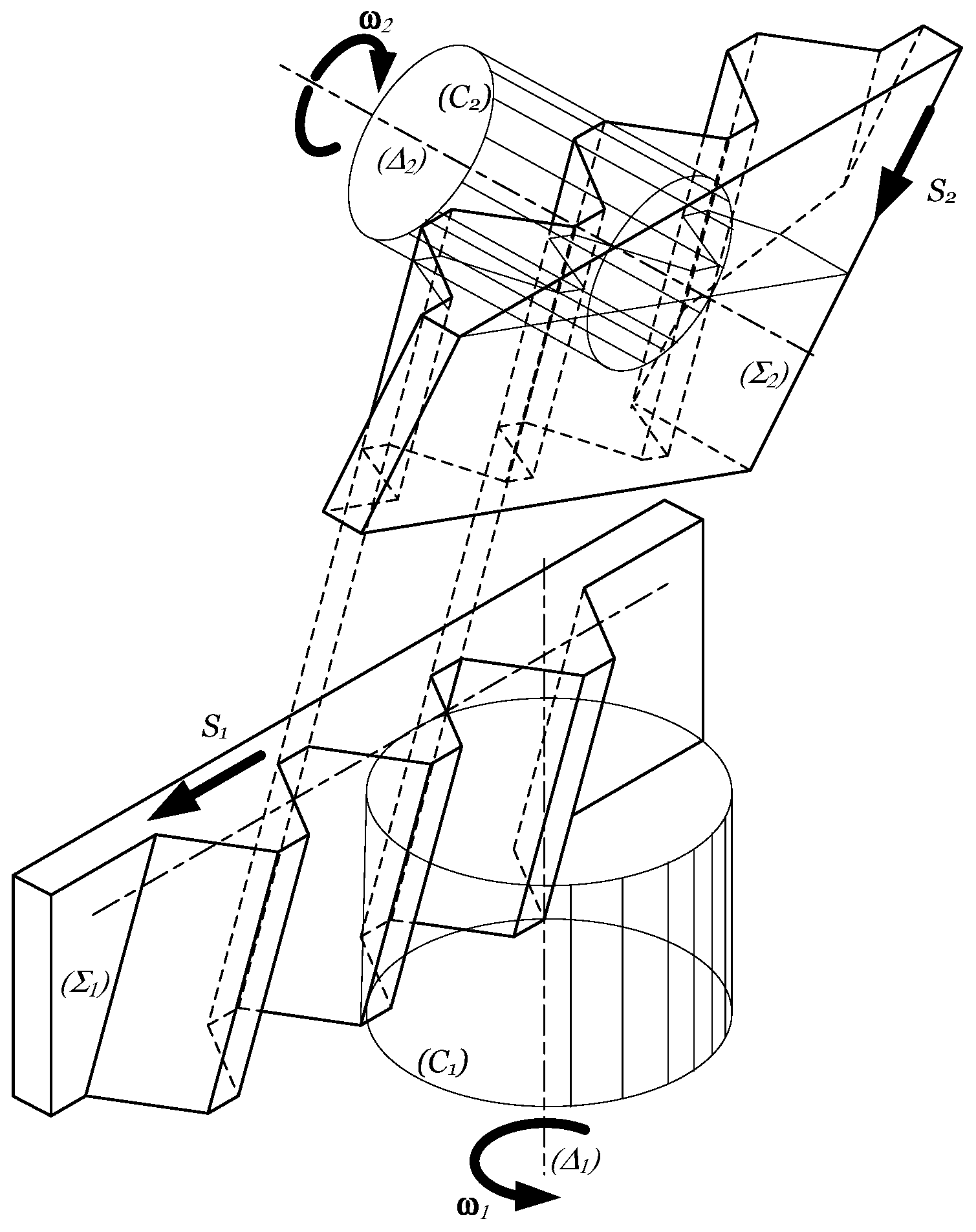
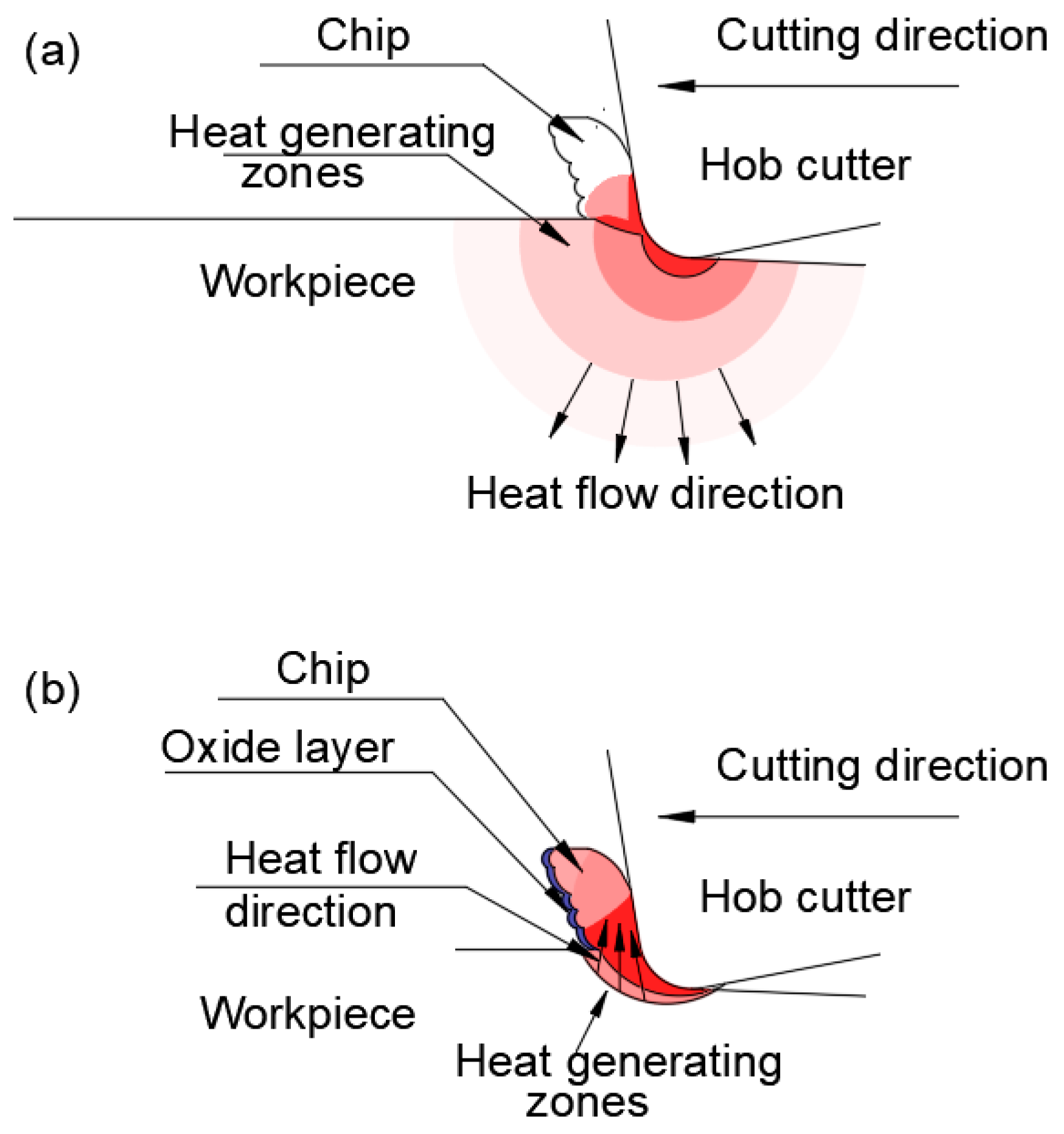
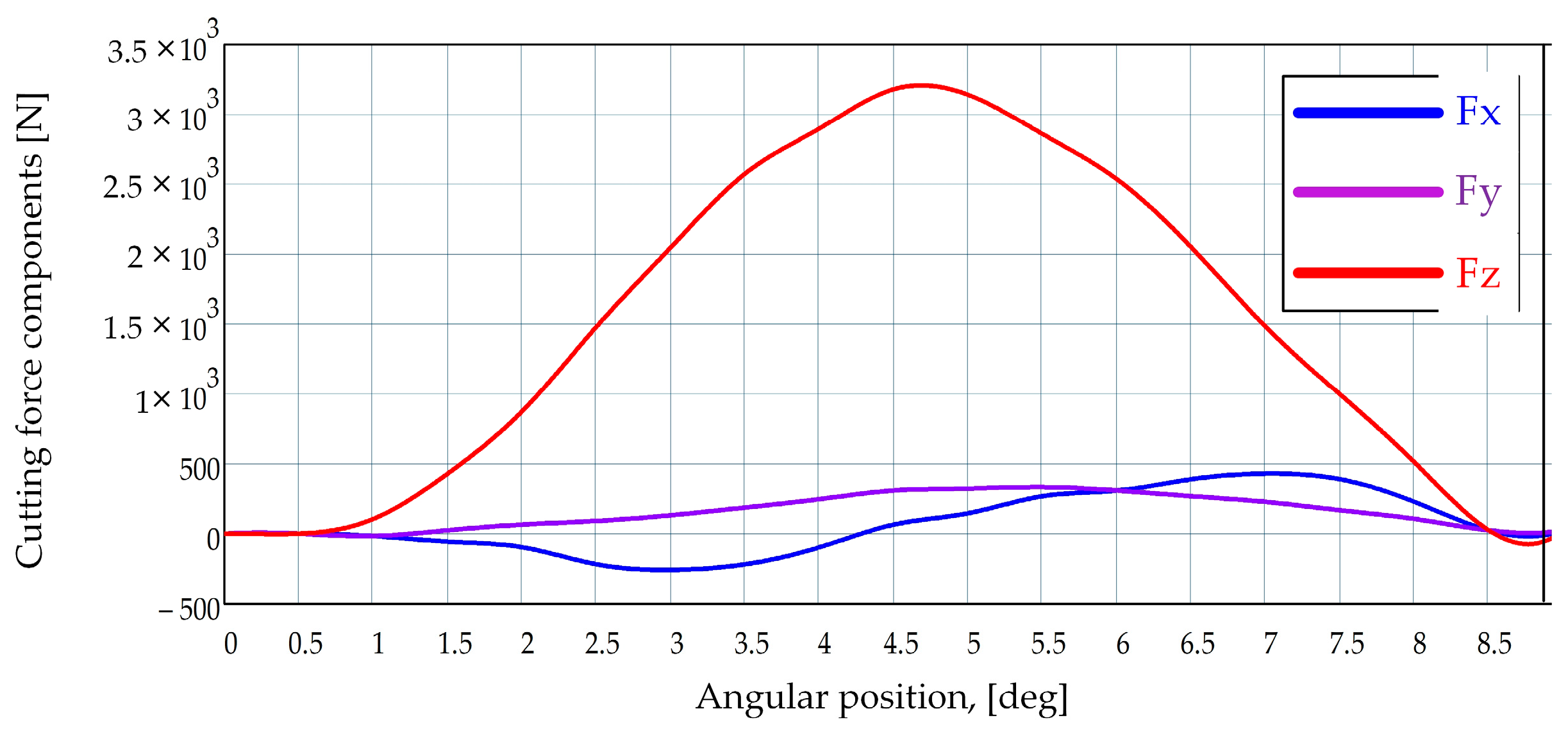
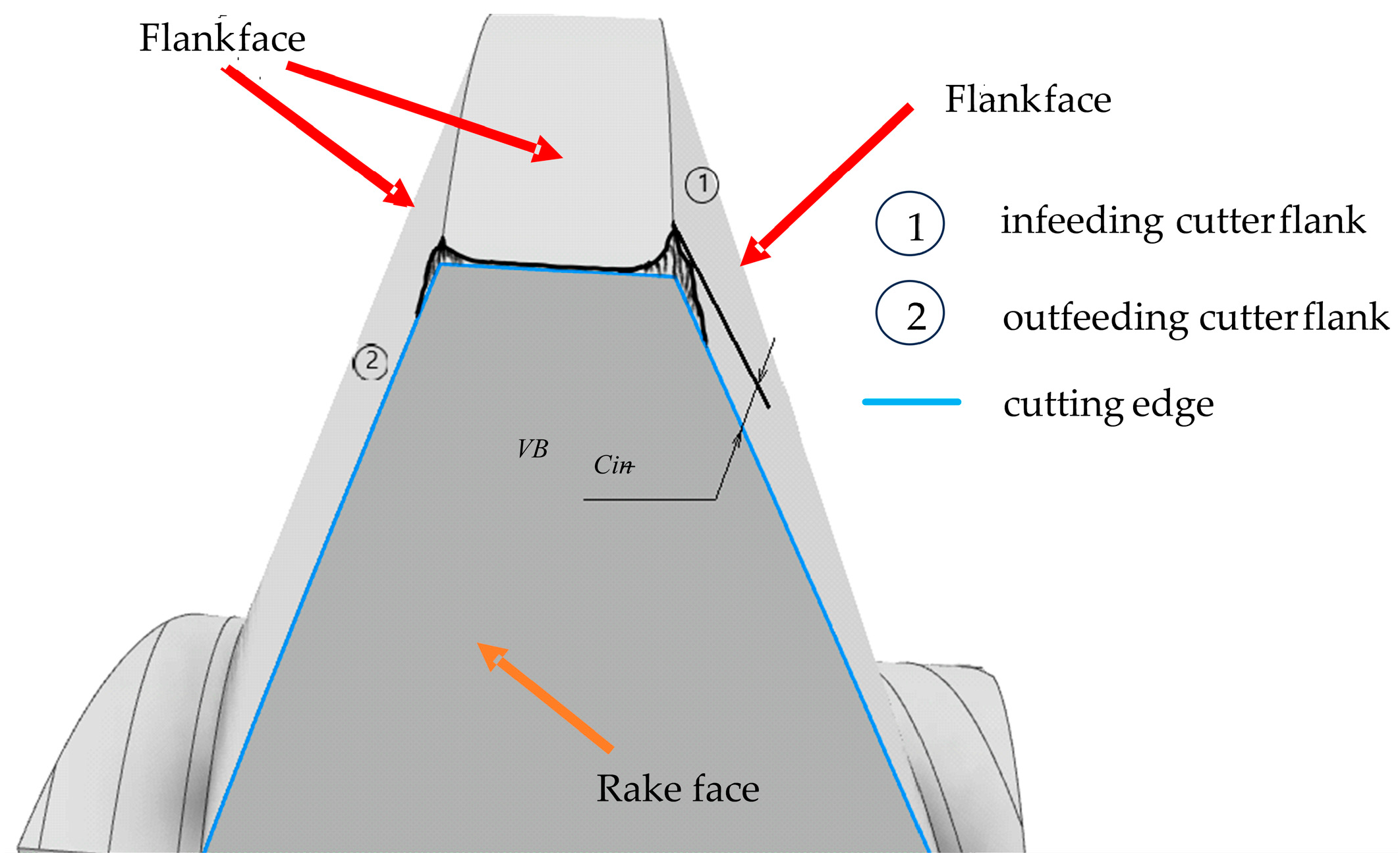
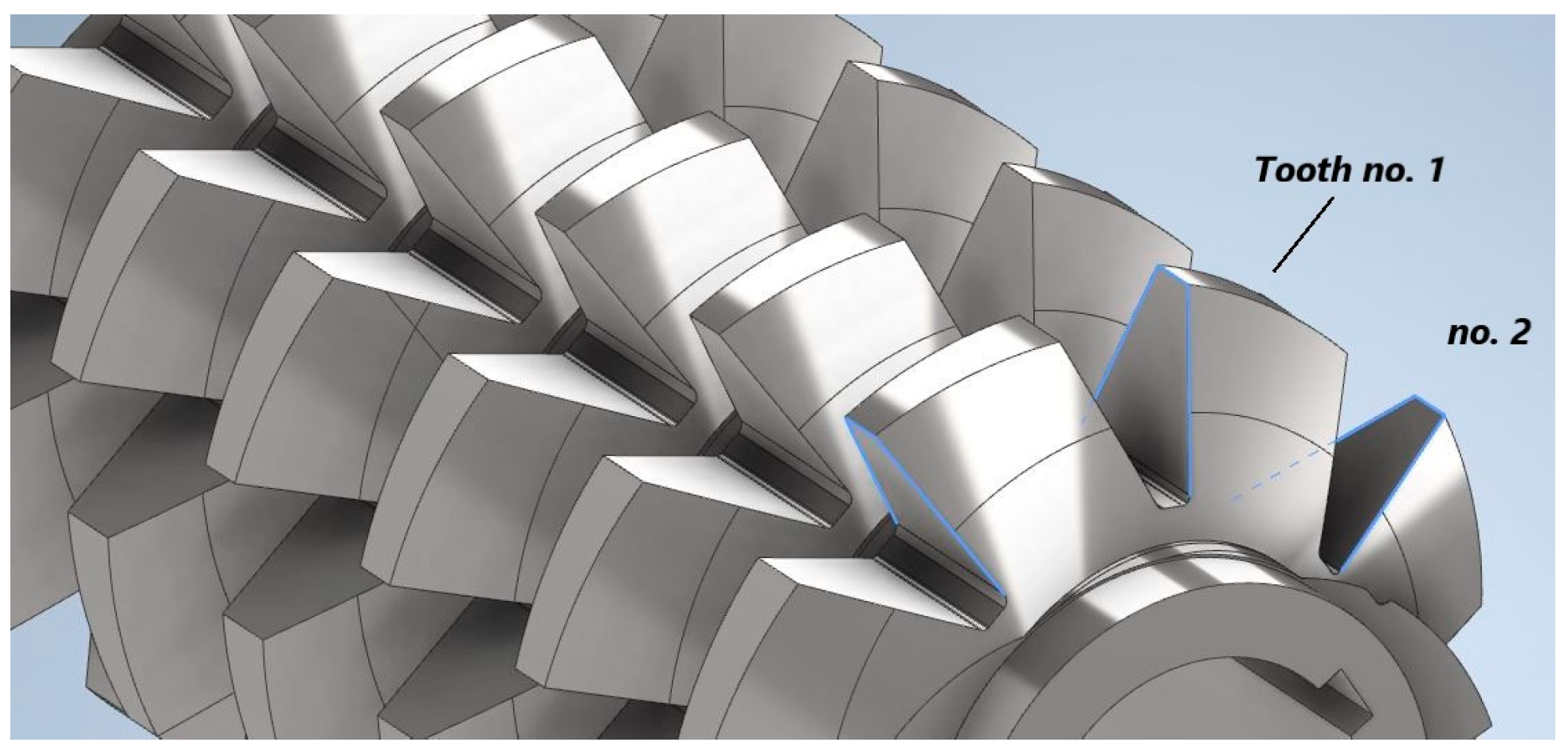




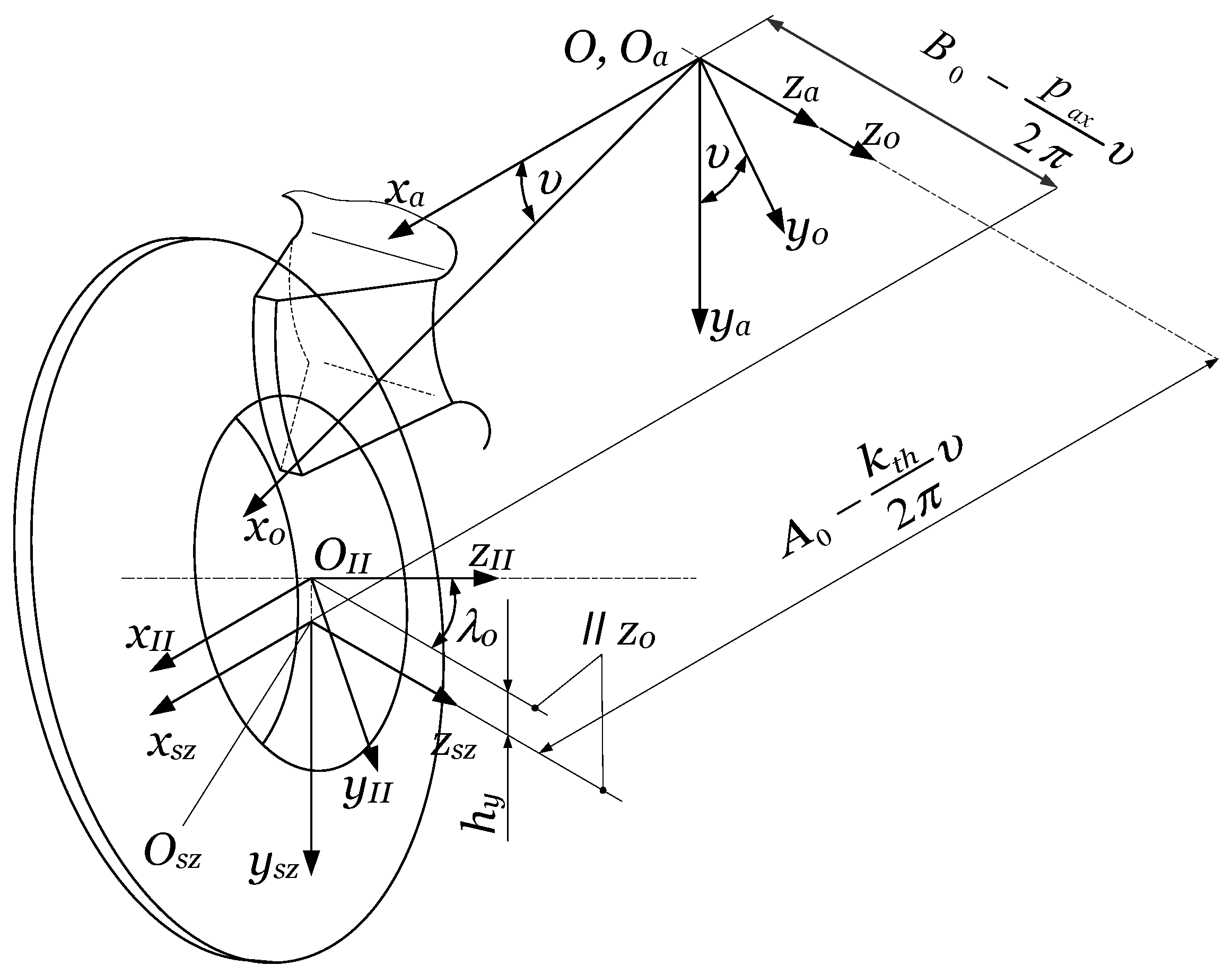
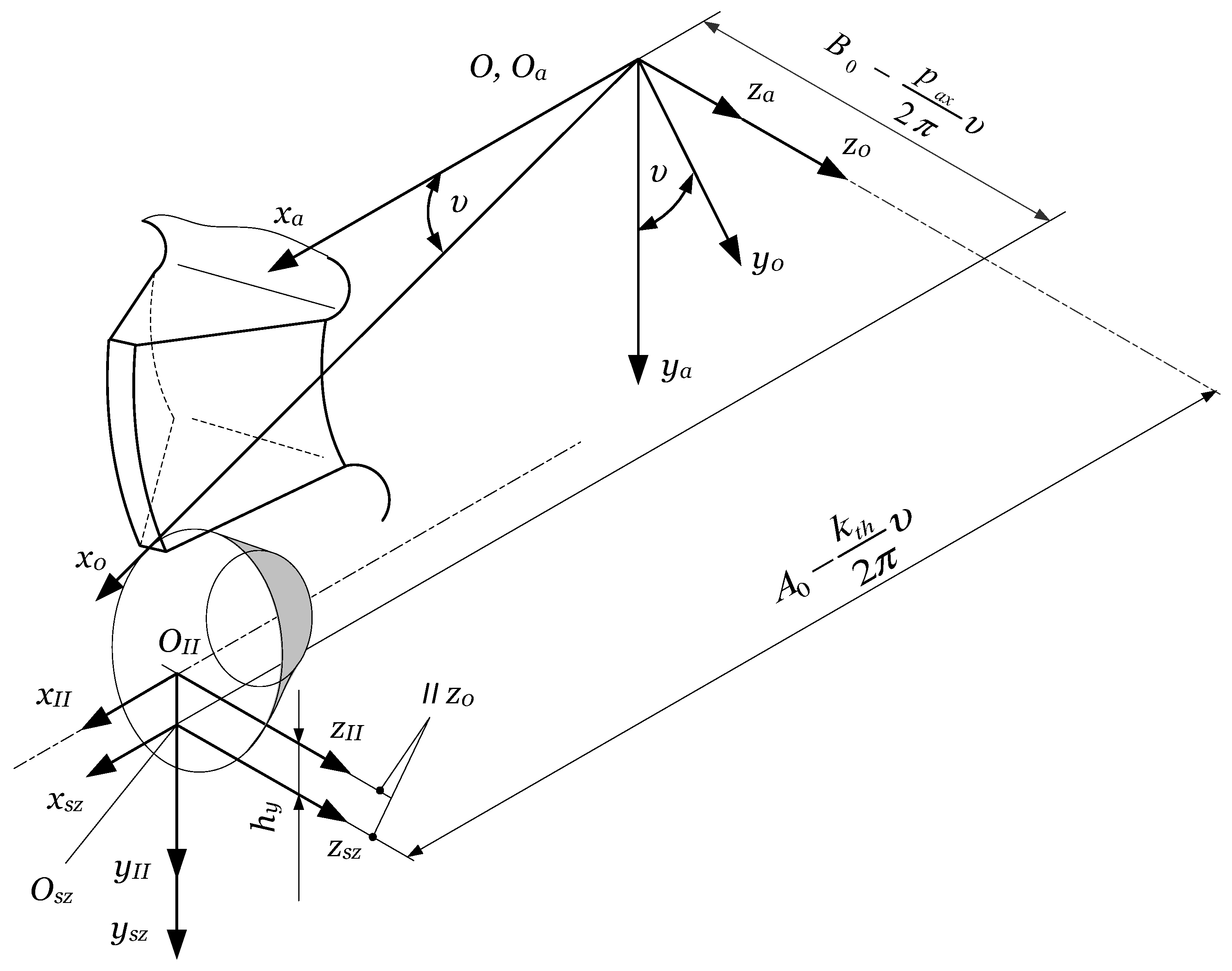
Disclaimer/Publisher’s Note: The statements, opinions and data contained in all publications are solely those of the individual author(s) and contributor(s) and not of MDPI and/or the editor(s). MDPI and/or the editor(s) disclaim responsibility for any injury to people or property resulting from any ideas, methods, instructions or products referred to in the content. |
© 2024 by the authors. Licensee MDPI, Basel, Switzerland. This article is an open access article distributed under the terms and conditions of the Creative Commons Attribution (CC BY) license (https://creativecommons.org/licenses/by/4.0/).
Share and Cite
Hodgyai, N.; Máté, M.; Oancea, G.; Dragoi, M.-V. Gear Hobs—Cutting Tools and Manufacturing Technologies for Spur Gears: The State of the Art. Materials 2024, 17, 3219. https://doi.org/10.3390/ma17133219
Hodgyai N, Máté M, Oancea G, Dragoi M-V. Gear Hobs—Cutting Tools and Manufacturing Technologies for Spur Gears: The State of the Art. Materials. 2024; 17(13):3219. https://doi.org/10.3390/ma17133219
Chicago/Turabian StyleHodgyai, Norbert, Márton Máté, Gheorghe Oancea, and Mircea-Viorel Dragoi. 2024. "Gear Hobs—Cutting Tools and Manufacturing Technologies for Spur Gears: The State of the Art" Materials 17, no. 13: 3219. https://doi.org/10.3390/ma17133219
APA StyleHodgyai, N., Máté, M., Oancea, G., & Dragoi, M.-V. (2024). Gear Hobs—Cutting Tools and Manufacturing Technologies for Spur Gears: The State of the Art. Materials, 17(13), 3219. https://doi.org/10.3390/ma17133219







